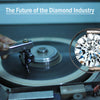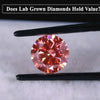
The Future of Lab Grown Diamonds: New Technologies and Innovations
Lab grown diamonds are transforming the jewelry industry by offering a sustainable, ethical, and affordable alternative to traditional mined diamonds. As technology continues to advance, the future of lab grown diamonds looks even brighter.
With innovations improving the creation, quality, and affordability of these diamonds, it's clear that lab grown diamonds are here to stay.
The Rise and Future of Lab Grown Diamonds
Lab grown diamonds have been gaining immense popularity in recent years. They are virtually identical to natural diamonds in terms of their physical, chemical, and optical properties. However, they are produced in a controlled laboratory environment using cutting-edge technologies. This makes them more affordable and sustainable than their mined counterparts.
Technological advancements have played a major role in driving the lab grown diamond industry forward.
High-pressure, high-temperature (HPHT) and chemical vapor deposition (CVD) are two methods that have been advancing diamond production. These methods allow for the creation of larger, higher-quality cut and shape diamonds at a lower cost. They are significantly contributing to the growth of the market.
Due to their ethical and environmentally friendly characteristics, lab grown diamonds are gaining popularity as a substitute for mined diamonds. With an anticipated growth rate of 22% between 2021 and 2026, the future of lab grown diamonds is promising.
Here are some potential advancements for lab grown diamonds in the future.
Role of Technology in Lab Grown Diamonds Sector in India
India is emerging as a major global hub for lab grown diamond manufacturing and processing. The country plays a significant technological role in the industry.
Polished lab grown diamond exports totaling approximately $1.05 billion between April 2021 and January 2022, according to the Gem & Jewellery Export Promotion Council.

A Major Player in the Global Jewelry Market
India’s gem and jewelry sector is one of the largest globally. It holds a sizable share of the global consumer market. The industry accounts for 29% of global jewelry consumption and employs nearly 5 million people annually.
With about 3 million players in the jewelry sector, India’s market and labor pool are vast. It’s a dominant force in the diamond industry.
Rising Demand for Sustainable Lab Grown Diamonds
The demand for lab grown diamonds is soaring. It’s largely driven by technological advancements and changing consumer behavior during the COVID-19 pandemic.
Lab grown diamonds are more affordable 50–60% cheaper than mined diamonds and also more sustainable and eco-friendly. They are becoming increasingly popular among consumers.
India's International Success and Domestic Growth
Indian lab grown diamonds are selling more internationally than domestically. However, the domestic market is growing steadily. As demand for sustainable diamonds increases, India is expected to see further developments that will position it as a key market for lab grown products.
India’s lab grown diamond industry began to shine in the mid-2000s and is projected to grow rapidly in the 2020s. Despite challenges during the COVID-19 pandemic, the industry has rebounded. This poses a strong challenge to naturally mined diamonds. Lab grown diamonds are meeting the demand for luxury and also aligning with sustainability values.

Regional Growth and Future Prospects
Major cities like Kolkata, Delhi-NCR, Chennai, and Mumbai are leading the demand for sustainable diamonds, with growth also spreading to Tier-2 cities. In the coming years, it is expected that the trend will extend to Tier-3 cities, further solidifying India's role in the lab grown diamond industry.
Advances in Technology for Creating Lab Grown Diamonds
Synthetic or cultured diamonds commonly called lab grown diamonds form in a laboratory setting using cutting-edge technology. Manufacturers create these diamonds more quickly and at a lower cost than natural diamonds. They replicate the same physical, chemical, and optical characteristics.
Here are some of the most recent technological developments for producing lab grown diamonds:
● High-Pressure High-Temperature (HPHT) Method
The HPHT method mimics the natural process of diamond formation by subjecting carbon to extreme pressure and temperature. This process has been resulting in larger and higher-quality lab grown diamonds. As technology improves, this method is becoming more efficient and cost-effective. This makes it possible to produce diamonds on an even larger scale.
● Chemical Vapour Deposition (CVD) Method
The CVD method involves introducing carbon-rich gases into a vacuum chamber. This chamber is where they bond to a diamond seed, forming a diamond layer. The technique offers more control over the diamond's growth.
It allows for diamonds of higher purity and better quality. As CVD technology progresses, the speed and cost of diamond production continue to improve.
● Microwave Plasma Chemical Vapour Deposition (MPCVD) Method
MPCVD uses microwave energy to create plasma, which enables the growth of diamond crystals. This variation of CVD technology is particularly useful for producing diamonds with high precision.
● Ultrasonic Cavitation-based Method
In this method, a diamond seed is placed in a carbon-rich liquid and exposed to ultrasonic waves. These waves create tiny bubbles that generate high pressure and temperature as they collapse–causing the carbon to crystallize into a diamond. This method is commonly used to produce small yet high-quality diamonds.
● Laser-assisted Method
This relatively new method uses lasers to heat a carbon source and transform it into a diamond. The laser can be precisely controlled to create high-quality diamonds with specific shapes and sizes.
Overall, advancements in lab grown diamond technology are making it possible to produce high-quality diamonds at a lower cost and with greater sustainability than traditional mining. As these technologies continue to improve, lab grown diamonds are expected to become the preferred alternative to natural diamonds.

Ethical and Environmental Considerations
Modern technical techniques that closely resemble the natural diamond formation process are used to make lab grown diamonds in a laboratory setting. Even if this technology has several advantages, there are still ethical and environmental issues to be aware of.
Several important factors are listed below:
● Energy Consumption
A significant amount of energy to produce is required for lab diamonds. The production process involves high-temperature, high-pressure conditions that require ample electricity. If non-renewable sources produce this energy, then this can have a significant environmental impact.
● Chemicals Used
Manufacturers use Chemical Vapour Deposition (CVD) or High-Pressure, High-Temperature (HPHT) processes to produce lab grown diamonds. These methods may involve harmful chemicals like hydrogen gas and methane. These chemicals can negatively impact the environment if not handled properly.
● Waste Disposal
Lab grown diamond production generates waste materials that require proper disposal. If manufacturers do not manage this waste correctly, it can lead to environmental harm.
● Impact on the Natural Diamond Industry
The growing popularity of lab diamonds has the potential to disrupt the natural diamond industry. It could negatively affect communities that depend on diamond mining for their livelihoods.

● Misleading Marketing Claims
Some businesses that sell lab grown diamonds may make misleading claims about the ethical and environmental benefits of their products. Customers should research brands carefully and choose those that are transparent about their production practices.
While lab grown diamonds offer a more ethical and sustainable alternative to natural diamonds, it’s important to understand the potential environmental impact of their manufacturing. Being informed helps customers support businesses that prioritize honesty and responsible practices.
As technology continues to advance, the future of lab grown diamonds holds exciting possibilities. With innovations in production methods and a growing demand for sustainable, ethical options, lab grown diamonds will play a significant role in the jewelry market for years to come.
At Diamondrensu, we are proud to be part of this transformative industry. We offer our customers a wide range of high-quality lab grown diamonds and moissanite jewelry that is both beautiful and ethically sourced.
As the market for lab grown diamonds continues to grow, we look forward to introducing even more innovative designs and expanding our collections. Embrace the future of diamonds and explore our collections today.
Leave a comment
Please note, comments must be approved before they are published.















